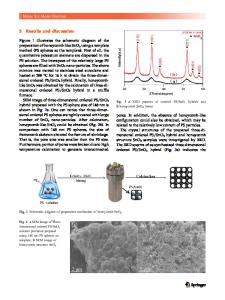Preparation and microwave absorption properties of Ni/rGO/EP composite foam
- PDF / 887,827 Bytes
- 9 Pages / 584.957 x 782.986 pts Page_size
- 92 Downloads / 335 Views
Preparation and microwave absorption properties of Ni/rGO/EP composite foam Zixuan Wang1, Qi Yu1,a), Weicheng Nie1, Ping Chen2 1
Faculty of Materials Science and Engineering, Liaoning Key Laboratory of Advanced Polymer Matrix Composites, Shenyang Aerospace University, Shenyang 110136, China 2 School of Chemical Engineering, State Key Laboratory of Fine Chemicals, Dalian University of Technology, Dalian 116024, China a) Address all correspondence to this author. e-mail: [email protected] Received: 25 February 2020; accepted: 20 May 2020
In this study, the Ni/rGO hollow microspheres were synthesized and combined with epoxy foam to prepare structural absorbing materials. The diameter of obtained rGO hollow microspheres loaded with Ni nanoparticles was around 10 μm and the thickness of the spherical wall was about 70 nm. The Ni/rGO/EP composite foam exhibited better microwave absorption properties than that of rGO/EP and Ni/EP composite foam. The minimum reflection loss value (RLmin) could reach −58.23 dB at 8.4 GHz with a thickness of 2.5 mm, and the effective bandwidth with RLmin lower than −10 dB is 2.21 GHz ranging from 7.46 to 9.67 GHz. The porous structure of Ni/ rGO hollow microspheres and their filled epoxy foam can refract and absorb the electromagnetic waves repeatedly, which equals to extend the propagation path of microwave, thus, electromagnetic loss capacity was improved obviously.
INTRODUCTION With the development of national defense science and technology, the development of high technologies in the military field has attracted the attention of numerous researchers [1]. The modern detection methods are diversified and advanced, and the stealth technology especially the stealth materials have played a key role in the military field for the unpredictability of war [2]. The selection of microwave absorbing materials is no longer a single component, which has been replaced by new-type composite materials due to their better absorbing performance. According to the forming process, the absorbing materials can be divided into structural and coating materials [3]. The absorbing coating MATERIALS have advantages of convenient construction and flexible design but increased extra weight has limited their practical applications. Thus, the structural absorbing materials have the potential to replace the absorbing coating materials due to their better properties [4, 5, 6, 7]. Graphene has excellent optical, electrical and mechanical properties and has important application prospects in materials science, micro-nano processing, energy, biomedicine and drug delivery [8, 9, 10]. Recently, graphenes have obtained extensive attention as new-type dielectric loss materials in many researches. Chen et al. [11] synthesized graphene nanosheets supporting Ni nanoparticles via one-pot method. The
© Materials Research Society 2020
minimum reflection loss value (RLmin) of nanocomposites was −17.8 dB with a thickness of 5 mm. Zhu et al. [12] prepared graphene–nickel (rGO–Ni) nanocomposites through a facile microwave-assisted he
Data Loading...











